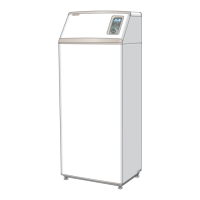Description of functions - Basic functions32
FIGHTER 1330
In those cases, additional heating is supplied using a
gas boiler you can choose to connect it as an oil boil-
er if you need to control a shunt valve or alternatively
connect it as an electric boiler.
See the section Description of functions - Basic func-
tions > Electrical additional heater to connect it as an
electric boiler and the section Description of functions
- Basic functions > Oil boiler to connect it as an oil boil-
er.
Gas boiler
HPAC can either be connected to the Base card or to
the Expansion card 1. When HPAC is to be connected
to the Base card the immersion heater can be run at a
maximum on one step.
Control of cooling mode takes place by means of an
outdoor sensor and, when connected, a room sensor
(RG 10/RG 05, see the section Description of func-
tions - Basic functions > Room control for a description
of the connection).
The control of cooling to the house takes place accord-
ing to the set curve slope and curve offset in menus
6.4.2 and 6.4.3. After adjustment, the house receives
the correct amount of cooling for the prevailing outdoor
temperature. The flow temperature from HPAC will fluc-
tuate around the theoretical required value (value in
brackets in menu 2.0). In the event of excess tempera-
ture, FIGHTER 1330 calculates a surplus in the form
of degrees-minutes, which means that the connection
of cooling production is accelerated the greater the
excess temperature that temporarily prevails.
FIGHTER 1330 automatically switches to cooling
mode when the outdoor temperature exceeds the set
value in menu 6.4.5.
Passive cooling means that FIGHTER 1330, with the
help of the circulation pumps, circulates fluid from the
soil/rock collector in the house's distribution system
and cools the house.
In the event of a large cooling requirement where pas-
sive cooling is not sufficient, active cooling is engaged
at the limit value set in menu 6.4.7. A compressor
then starts and the cooling produced circulates to the
house's distribution system and heat is circulated out
to the soil/rock collector. When more compressors are
available, these will start with a difference on the set
degree-minute setting in menu 6.4.8.
Three different cooling curves can be selected, see
the figure for a detailed description.
If room sensors (RG 10/RG 05) are connected, cool-
ing starts at a 1 degree excess temperature in the
room and the supply calculation counts on an outdoor
temperature of 30 °C (if the outdoor temperature is
greater, then the actual outdoor temperature is used).
When the room temperature has fallen to 0.5 degrees
of excess temperature, the cooling is switched off. To
prevent self-oscillation in the heating system, there is a
neutral zone between heating and cooling operations.
Lower shunt (SV-V2) is regulated during cooling oper-
ation in opposite direction to heating operation, which
normally means the shunt closes completely during
cooling operation.
HPAC
NOTE!
This system solution means that the
brine will also circulate through the
heating system. Check that all compo-
nent parts are designed
for the brine in question.
0
0
°C
20
°C
30
5
10
20
Beräknad
framledningstemp.
Utetemp.
40
15
k=1
k=2
k=3
c=1
c=2
Outdoor
temperature
Calculated
flow temperature
c=3
LEK
X6 X6A
The outline diagram with docking instruc-
tions is available at www.nibe.com

